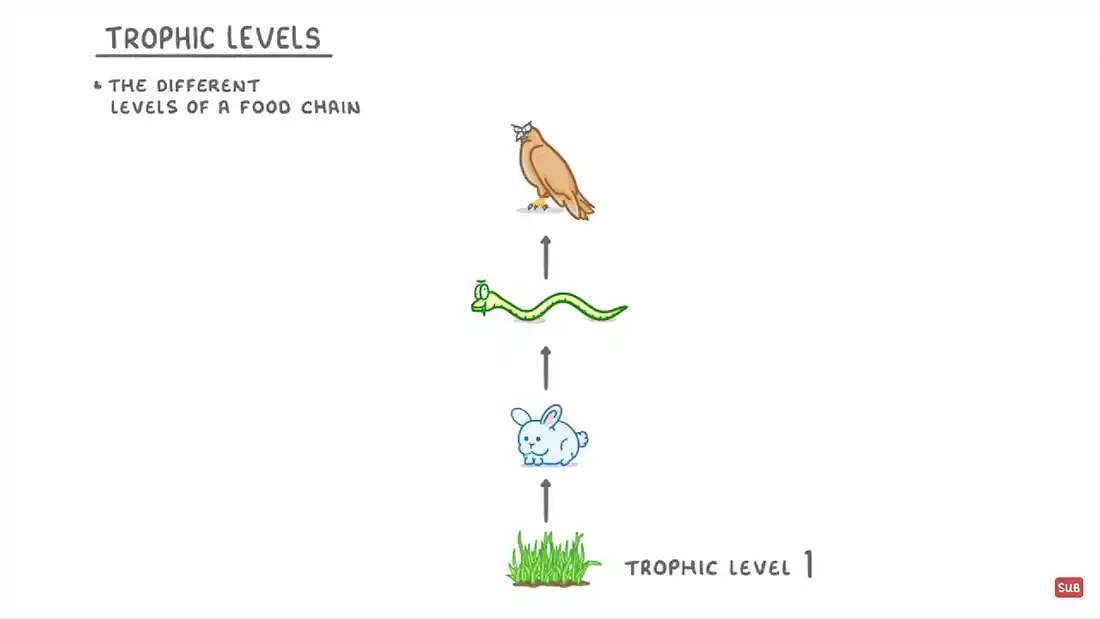

Trophic, level, herbivore, carnivore, omnivore, decomposers, consumers, producers, energy pyramid, primary, secondary, tertiary.
The way we look at organisms in the natural is hierarchical, meaning that things go in a certain order. When we look at a simple food chain, we know that one things eats anotherm, until there is nothing that gets eaten at the top of that chain. How else can we look at it?
A trophic level is the level in which a food chain can also be split up. If you take a simple food chain (like the one given on the right), you will notice that the grass is the producer. Next, the grasshopper will eat the grass, making it a consumer. So on, until the hawk at the end becomes the apex predator.
Trophic levels have different names. They are also sometimes called energy pyramids. The bottom layer is the most abundant, so creates the most energy. As you go up the pyramid, less energy is used or consumed.
So, how else can we measure this? By introducing trophic levels. Think of it like a pyramid. At the bottom of that pyramid (where usually there is a lot of stone), we can see the producers. They are the most abundant of lifeforms - plants, algae. They give us the oxygen we need to breathe.
There are other layers to look at as well:
So, as mentioned above, plants and algae cover the first base. These are all producers. But producers of what? Well, they "ingest" sunlight, and create oxygen. We use this oxygen to breathe, and in turn they use the carbon dioxide we breathe out to produce more oxygen. It's a never ending cycle.
This level includes all plants such as trees, the grass, flowers, and any other vegetation that uses photosynthesis. IT also includes certain forms of algae. They also produce oxygen, from the oceans and waters they live in. In fact, they produce the most amount of oxygen (over 60%) that we need to survive.
What are herbivores? They are simply organisms and small creatures that eat plant life only. Grasshoppers, some small rodents and other small creatures will eat the grass. They are not predators of any other animal.
To better understand this, they are also called primary consumers. They consume the plant life that is created.
Next up are carnivores. These are the first line of creatures or animals that will eat other animals. In the form of our food chain, we know that a mouse will eat small insects like a grasshopper. To the grasshopper, they are prey for the mouse. But mice are also prey.
There are several layers that include the consumers, as there might be more than one carnivore in the food chain. So your trophic diagram may have more or less levels in it.
The following still is from a video on trophic levels, with the following details:
Please click on the image to view the video.

The fourth level. This is where carnivores are eating other carnivores. In reference to our food chain, this is the snake eating the mouse. While a mouse can eat grasses as well as other insects and smaller rodents, they are classified as omnivores.
The tertiary level is now getting to the top of the trophic levels, which means there is less energy being used.
The very top of the tropic diagram shows the apex predator. This is the only carnivore that is able to prey on other animals, and has no known predators. In the food chain example, this is the hawk.

There is much debate on whether humans are classed as an apex predator. While there is no real evidence of being preyed on, because we have such varied cultures, it could be considered true or false depending on where you live.
What if there are more than one food chain, like within a food web? Well, this will have the same effect. You can make a trophic diagram for any food chain or web, but it will just show the different levels together.
If you are unable to see the board, please click here.
Disclaimer | About Me | Sitemap
Website design by SyntaxHTML.



Blue icons adapted from icons courtesy of Smashicons.com